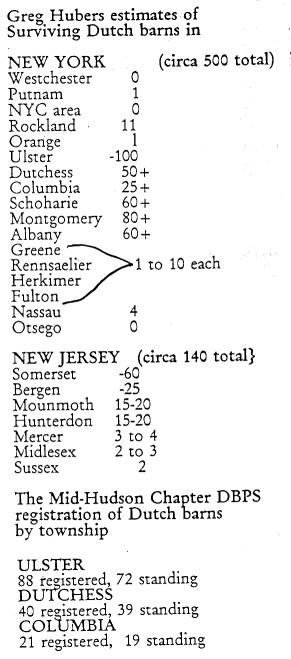|
HVVA
NEWSLETTER, January 2000 IMPORTANT FIRST MEETING OF THE MID-HUDSON CHAPTER of the DBPS DUTCH BARN PRESERVATION SOCIETY From the Editor.. The unofficial Mid-Husdon Chapter now has 68 paying members, $108 in the working account. and $245, in the Oliver Barn Fund. There is a need to have a first business meeting concerning organization, goals and plans for a not-for-profit status for the chapter. A meetIng is being called in Ulster County on Sunday, January 9, 2000 at 1:30 PM in the Marbletown Firehouse off Route 209, 5 miles west of the Kingston traffic-circle exit. The firehouse is a half mile from the Oliver barn, the chapter's temporary headquarters. After the firehouse meeting there will be a tour of the circa 1760 OlIver Dutch barn. There are a number of ideas among the chapter membership that will be presented. Most important will be a statement of purpose and how we will define our geographic area of interest. The Dutch Barn Preservation Society began ten years age with an emphasis on the Dutch barn but soon its newsletter was describing the hay barrack, the sith and matthook, the Dutch wagon and most recently the Dutch house. The Mid-Hudson Chapter shares this broad interest it the material culture of the New World Dutch and while the focus is on the Dutch the chapter's interest includes all that is traditional, rural and vernacular. An 18 page article with eleven photographs by Greg Huber: describes the last eleven Dutch barns to survive In Rockland County, New York (*). Greg is a resident of Wycoff New Jersey, and a person who has spent many years looking at traditional barns and timber framing in the northeast and in Pennsylvania. According to his article, only 500 Dutch barns remain standing in New York State and 140 in New Jersey. In a recent conversation he said these figures may be slightly low. These few surviving Dutch barns are of course often quite altered from their original form, a few are still in use but only a handful contain good evidence of their original uses. Of the eleven Dutch barns that have survived in Rockland County, New York, only the , CIrca 1810 Post/Sterbenz bam that was moved from Spring Valley and reconstructed in 1998 at a museum site owned by the town of Conyers with the restored 18th century Paul Schuler Dutch frame house. This barn is a true-form example with wagon doors on the gable-ends, all 10 others Rockland County Dutch barns have side entrances. Most of these were originally true-form barns altered by raising and rotating the roof ridge 90 degrees. Rotated roofs are common in New Jersey (**), where 35 to 40 examples survive. In Ulster County the roofs were more often raised by extending the columns and side walls but maintaining the same roof ridge-line. One of the Rockland County Dutch barns, a circa 1825 example in Palisades, Greg Huber describes as a "one-aisle barn". He also refers to the true-form Dutch Barn as a three aisle barn with two side aisles and a center aisle. I was recently criticized in a letter by Karen Gross, a timber frame enthusiast from Breitenheim, Germany (***) for my use of the term "single-aisle". She refers, to our center-aisle as "the nave" and suggested the term no-aisle barn for a Dutch barn without side, aisles. I have adopted her terminology because it seems more precise and uses less letters. How about a Dutch Barn Glossary of Terms?
By phone, Greg has told me that my use of "H-bent columns" is incorrect and that he now refers to those timbers as posts. Despite our inconsistent terminology we know what is meant most of the time. Greg Huber makes a number of observations concerning regional style. He feels the18th century Rockland County Dutch barns, like those of Bergen County, New Jersey, share an affinity with those in Ulster County, especially in the use of lap-dovetail joining and possibly major/minor rafter systems. Only three of SIX barns examined in Rockland County have raising holes. I believe all Ulster and Columbia and all Dutchess County Dutch barns, except the 1740s Verplank barn have them. Greg writes, "Wooden pins were inserted in the raising holes and connected to ropes that were in turn connected to a gin pole or hoisting mechanism." It has bee suggested that raisng-holes were used in several ways. * Dutch Barns in the Stony Lands of Rockland County,
by Greg Huber, South of the Mountains: Journal of the Rockland County
Historical Society, Vol. 43, No.4. Especially important is the authors estimate of surviving Dutch barns that I have summarized below. In Fitchen's 1968 classic study of the Dutch barn, he documented 76 examples in New York and New Jersey. Nine of these were in Ulster County. One barn in Hurley was already in a state of collapse but today, 32 years later, only three of Fitchen's nine barns have survived.
Peter Sinclair, editor Copyright ? 2004. Hudson Valley Vernacular Architecture. All rights reserved. All items on the site are copyrighted. While we welcome you to use the information provided on this web site by copying it, or downloading it; this information is copyrighted and not to be reproduced for distribution, sale, or profit.
|
